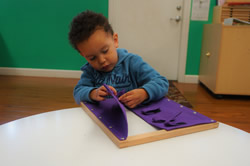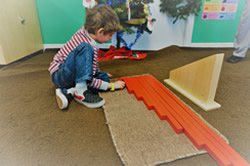WHY MONTESSORI
|
Montessori education is an educational approach developed by Italian physician and educator Dr. Maria Montessori and characterized by an emphasis on independence, freedom within limits, and respect for a child’s natural psychological, physical, and social development. It succeeds because it draws its principles from the natural development of the child.
FLEXIBILITY & PREPARED ENVIRONMENTS
The inherent flexibility allows the method to adapt to the needs of the individual, regardless of the level of ability, learning style or social maturity. She believed the needs, talents, gifts, and special individuality of each child were important as a guide. Using this approach she created “prepared environments” for multi-age groups (0-3, 3-6, 6-9, 9-12, and 12-14). The environments contain specifically designed materials for development that invite children to engage in learning activities of their own choice. Under the guidance of a trained teacher, children in a Montessori classroom learn by making discoveries with the materials, cultivating concentration, motivation, self-discipline, and a love of learning.
HANDS ON APPROACH
Montessori is a hands-on approach to learning that encompasses the use of the five senses, kinetic movement, spatial refinement, and small and large motor skill coordination. With this concrete knowledge, children find their own way to an understanding of concepts. This is combined with a deep love and need for purposeful work.
SELF RELIANCE
5 MAIN AREAS OF FOCUS
PRACTICAL LIFE

Some life skills focus on pouring, buttoning, shoe tying and other activities that develop coordination and developing motor skills
SENSORY

Helping children develop, explore and understand their sense of taste, smell, sight, touch, and hearing.
MATH

Some math skills consist of using concrete forms to learn things, including beads and boards
LANGUAGE

Helping children basic writing and reading like rhyming and letters, developing hand strengh, sand paper letter tracing.
CULTURAL

Exposing the child to basics in geography, racial groups, history, and life sciences. Music, art, and movement education are part of the integrated cultural curriculum”






